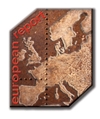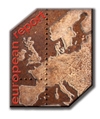Sean Milmo, Ink World European Editor01.11.10
Carbon footprints are gaining in importance in the European printing industry as the sector comes under growing pressure from brand owners and retailers for more data to be made available on the amounts of CO2 emitted to make printed products.
For ink producers the trend poses a big challenge. Although inks make up a relatively small proportion of printed materials, working out their carbon footprints can be difficult because of the wide range of ink formulations and the numerous chemicals within them.
Carbon footprints comprise the total quantity of CO2 and other global warming gases (GHGs), such as methane and nitrous oxide, which have been emitted along the entire supply chain of a product. This can stretch from the source of the raw materials to recycling and final disposal.
The big driver behind the growing belief in carbon footprints in Europe is the increasing awareness among consumers of the need to curb global warming. But manufacturers themselves are realizing that they are an effective means of reducing energy consumption at a time of a constant threat of increasing energy prices.
Measuring carbon footprints is not easy, even when they are restricted to production and printing processes, let alone when they are applied to raw materials. There are big difficulties in making the carbon emission data from different printing systems comparable to each other.
Variations in energy consumption can emerge even when printers are using the same types of printing presses with identical inks and other consumables. There can even be contrasting methods for converting of the levels of energy consumption into CO2 emissions.
Currently trade associations, producer groups and even single companies in the European printing industry are tending to draw up or use different standards for measuring of carbon footprints. There are fears that if their application becomes too fragmented they will lose credibility.
Already some experts are suggesting that the whole procedure of creating a carbon footprint system which is acceptable throughout the industry is too fraught with difficulties. Instead the sector should concentrate on less ambitious targets, such as raising energy efficiency which would both lower costs and help the environment.
However, the demand for CO2 emissions data, particularly among customers and end-users in packaging, is so strong that the present drive for carbon footprints is probably unstoppable. Furthermore, many companies, including ink producers, have committed themselves to sustainability policies in which the initiatives to help combat global warming play a big part.
“Not only do our customers have a sustainability program, but we have one ourselves,” said a marketing executive at one European ink company. “Obviously we take the idea of carbon footprints very seriously and are preparing our own plans for introducing them.”
IKEA has shown the importance itself and other large retailers give to sustainability and lower CO2 emissions in its latest 2010 catalog. In the printing of 198 million copies in 28 languages and 54 editions, the company boasts it was able to achieve a level of CO2 emissions per copy lower than last year’s catalog, from which the emissions were 0.69 kilograms per copy.
The retail chain also points out that printing and other suppliers must have a certified environmental management system and must monitor their consumption of resources, such as water and energy with data on CO2 emissions.
“In today’s printing industry, customers and the marketplace are being required to report on their sustainability performance, and brand owners and suppliers to brand owners are strongly indicating a need to satisfy sustainability requirements,” said Gary Andrzejewski, Sun Chemicals’s corporate vice president of environmental affairs.
“As a result, our customers want to know what their suppliers are doing to improve their sustainability performance and reduce their carbon footprint,” he added.
Sun Chemical has just issued its first sustainability report with data on its environmental performance, including the carbon footprints of 170 company sites in more than 25 countries.
The company has also started an analysis of the carbon footprints of its products, including an assessment of eight different ink lines representing 85 percent of its portfolio. The company has also launched a consultancy service to assist printers in tackling their environmental, health and safety problems including those relating to carbon footprints.
The company is seeking as well to meet the environmental needs of its own customers. “(We) manufacture product that are designed specifically to improve the carbon footprint of our customers,” said Mr. Andrzejewski. “These products have a high content of bio-based and renewable resource materials, and are created to help reduce waste, increase productivity and decrease energy usage.”
Suppliers of raw materials for printing inks are also anxious to impress upon customers the sustainability of their products, as demonstrated through their own carbon footprint data.
“With the issue of carbon footprints gaining a much higher profile, we believe that they are a very good way of measuring sustainability,” said Jan Besamusca, innovation director at DSM Resins.
Manufacturers of printing presses and equipment have also launched their own sustainability programs. These are aimed at both reducing their own carbon footprints and those of their printer customers.
Underlying the adoption by companies of sustainability and carbon footprint strategies is a competition to demonstrate that certain printing processes have an environmental performance superior to others.
European trade associations presenting the gravure, offset and flexographic sectors have, for example, being doing a lot of work on the gathering of comparative carbon footprint data on their processes.
“With printing processes using old equipment, there is not much difference between the carbon footprints of a gravure process and one, for example, using web offset,” said Josef Bernard, technical coordinator at the European Rotogravure Association (ERA). “The carbon footprint of a process changes with the age of the equipment. New equipment will consume less energy and have a lower carbon footprint. Energy costs are now a major determining factor behind the design of presses. On the whole, the gravure process with new equipment is more energy efficient than a new offset press. The gravure process recovers 95 percent of toluene, while with the modern offset process, solvents are burned.”
There is an even more intense battle taking place between producers of printing substrates – in particular between plastic and paper companies supplying packaging converters. Paper has the benefit of being effectively a biomaterial while plastic has the environmental advantages of flexibility and a low weight, which cuts CO2 emissions during transportation.
“In packaging, there is still a lot of discussion about comparisons between paper and plastic in terms of sustainability,” said Mr. Besamusca. “But on the whole, consumers tend to favor paper because they perceive it as being greener. This could have an impact on demand for inks because inks for plastic packaging are quite different from inks in paper packaging. We are seeking to match the demand for ‘green’ paper packaging with the supply of ‘green’ resins. We are introducing resins with a lower carbon footprint.”
While plastic is ultimately derived from fossil fuels, paper is not only sourced from renewable material but also one that captures CO2. At the same time, a high proportion of printed matter on paper is recycled.
In Europe, around 50 million tons of used paper is collected for recycling each year. In addition, the forests of Finland, the region’s major paper producer, achieve a net absorption of 30 million ton of CO2 because more trees are planted than harvested.
“In some European countries, 80 percent of printed matter on paper is now being recycled,” said an environmental analyst in the printing industry. ”Paper which is first used for printing magazines is then, after recycling, used as newsprint, and then when that is recycled it is used for making cartons. This amount of reuse of a material is pretty unique.”
On the sustainability front, the European printing industry as a whole is also fighting the electronic media on the issue of energy consumption and carbon emissions.
Currently it is an area in which the printing industry, including the paper sector, is failing to communicate effectively its superior environmental performance. A recent study in the UK of media buyers found that 50 percent of respondents thought that paper had a high carbon footprint while 80 percent believed that electronic communications were more environmentally friendly than paper.
One person reading a daily newspaper uses the equivalent of 28 kg of CO2 per year, according to figures from the ERA. An individual reading news on the internet for 30 minutes a days used 35 kg of CO2 annually when the carbon footprint of the life cycle of a computer from manufacturing to disposal is taken into account.
To meet the needs of customers, ink manufacturers are working on ‘greener” inks. New inks frequently have energy-saving properties while also containing bio-based materials such as vegetable-oil derivatives in order to reduce their carbon footprint. For example, Sun Chemical has recently introduced an ink for the sheetfed market which has ultra-fast drying capabilities that help printers reduce energy consumption.
Carbon footprints can be seen to be too complicated and unreliable by customers along the value chain. Still, many printers and end-users in Europe are likely to be intent on introducing carbon footprints. As a result, ink producers will have to continue to look after their needs.
 |
Carbon footprints comprise the total quantity of CO2 and other global warming gases (GHGs), such as methane and nitrous oxide, which have been emitted along the entire supply chain of a product. This can stretch from the source of the raw materials to recycling and final disposal.
The big driver behind the growing belief in carbon footprints in Europe is the increasing awareness among consumers of the need to curb global warming. But manufacturers themselves are realizing that they are an effective means of reducing energy consumption at a time of a constant threat of increasing energy prices.
Measuring carbon footprints is not easy, even when they are restricted to production and printing processes, let alone when they are applied to raw materials. There are big difficulties in making the carbon emission data from different printing systems comparable to each other.
Variations in energy consumption can emerge even when printers are using the same types of printing presses with identical inks and other consumables. There can even be contrasting methods for converting of the levels of energy consumption into CO2 emissions.
Currently trade associations, producer groups and even single companies in the European printing industry are tending to draw up or use different standards for measuring of carbon footprints. There are fears that if their application becomes too fragmented they will lose credibility.
Already some experts are suggesting that the whole procedure of creating a carbon footprint system which is acceptable throughout the industry is too fraught with difficulties. Instead the sector should concentrate on less ambitious targets, such as raising energy efficiency which would both lower costs and help the environment.
However, the demand for CO2 emissions data, particularly among customers and end-users in packaging, is so strong that the present drive for carbon footprints is probably unstoppable. Furthermore, many companies, including ink producers, have committed themselves to sustainability policies in which the initiatives to help combat global warming play a big part.
“Not only do our customers have a sustainability program, but we have one ourselves,” said a marketing executive at one European ink company. “Obviously we take the idea of carbon footprints very seriously and are preparing our own plans for introducing them.”
IKEA has shown the importance itself and other large retailers give to sustainability and lower CO2 emissions in its latest 2010 catalog. In the printing of 198 million copies in 28 languages and 54 editions, the company boasts it was able to achieve a level of CO2 emissions per copy lower than last year’s catalog, from which the emissions were 0.69 kilograms per copy.
The retail chain also points out that printing and other suppliers must have a certified environmental management system and must monitor their consumption of resources, such as water and energy with data on CO2 emissions.
“In today’s printing industry, customers and the marketplace are being required to report on their sustainability performance, and brand owners and suppliers to brand owners are strongly indicating a need to satisfy sustainability requirements,” said Gary Andrzejewski, Sun Chemicals’s corporate vice president of environmental affairs.
“As a result, our customers want to know what their suppliers are doing to improve their sustainability performance and reduce their carbon footprint,” he added.
Sun Chemical has just issued its first sustainability report with data on its environmental performance, including the carbon footprints of 170 company sites in more than 25 countries.
The company has also started an analysis of the carbon footprints of its products, including an assessment of eight different ink lines representing 85 percent of its portfolio. The company has also launched a consultancy service to assist printers in tackling their environmental, health and safety problems including those relating to carbon footprints.
The company is seeking as well to meet the environmental needs of its own customers. “(We) manufacture product that are designed specifically to improve the carbon footprint of our customers,” said Mr. Andrzejewski. “These products have a high content of bio-based and renewable resource materials, and are created to help reduce waste, increase productivity and decrease energy usage.”
Suppliers of raw materials for printing inks are also anxious to impress upon customers the sustainability of their products, as demonstrated through their own carbon footprint data.
“With the issue of carbon footprints gaining a much higher profile, we believe that they are a very good way of measuring sustainability,” said Jan Besamusca, innovation director at DSM Resins.
Printing Processes
Manufacturers of printing presses and equipment have also launched their own sustainability programs. These are aimed at both reducing their own carbon footprints and those of their printer customers.
Underlying the adoption by companies of sustainability and carbon footprint strategies is a competition to demonstrate that certain printing processes have an environmental performance superior to others.
European trade associations presenting the gravure, offset and flexographic sectors have, for example, being doing a lot of work on the gathering of comparative carbon footprint data on their processes.
“With printing processes using old equipment, there is not much difference between the carbon footprints of a gravure process and one, for example, using web offset,” said Josef Bernard, technical coordinator at the European Rotogravure Association (ERA). “The carbon footprint of a process changes with the age of the equipment. New equipment will consume less energy and have a lower carbon footprint. Energy costs are now a major determining factor behind the design of presses. On the whole, the gravure process with new equipment is more energy efficient than a new offset press. The gravure process recovers 95 percent of toluene, while with the modern offset process, solvents are burned.”
There is an even more intense battle taking place between producers of printing substrates – in particular between plastic and paper companies supplying packaging converters. Paper has the benefit of being effectively a biomaterial while plastic has the environmental advantages of flexibility and a low weight, which cuts CO2 emissions during transportation.
“In packaging, there is still a lot of discussion about comparisons between paper and plastic in terms of sustainability,” said Mr. Besamusca. “But on the whole, consumers tend to favor paper because they perceive it as being greener. This could have an impact on demand for inks because inks for plastic packaging are quite different from inks in paper packaging. We are seeking to match the demand for ‘green’ paper packaging with the supply of ‘green’ resins. We are introducing resins with a lower carbon footprint.”
While plastic is ultimately derived from fossil fuels, paper is not only sourced from renewable material but also one that captures CO2. At the same time, a high proportion of printed matter on paper is recycled.
In Europe, around 50 million tons of used paper is collected for recycling each year. In addition, the forests of Finland, the region’s major paper producer, achieve a net absorption of 30 million ton of CO2 because more trees are planted than harvested.
“In some European countries, 80 percent of printed matter on paper is now being recycled,” said an environmental analyst in the printing industry. ”Paper which is first used for printing magazines is then, after recycling, used as newsprint, and then when that is recycled it is used for making cartons. This amount of reuse of a material is pretty unique.”
On the sustainability front, the European printing industry as a whole is also fighting the electronic media on the issue of energy consumption and carbon emissions.
Currently it is an area in which the printing industry, including the paper sector, is failing to communicate effectively its superior environmental performance. A recent study in the UK of media buyers found that 50 percent of respondents thought that paper had a high carbon footprint while 80 percent believed that electronic communications were more environmentally friendly than paper.
One person reading a daily newspaper uses the equivalent of 28 kg of CO2 per year, according to figures from the ERA. An individual reading news on the internet for 30 minutes a days used 35 kg of CO2 annually when the carbon footprint of the life cycle of a computer from manufacturing to disposal is taken into account.
To meet the needs of customers, ink manufacturers are working on ‘greener” inks. New inks frequently have energy-saving properties while also containing bio-based materials such as vegetable-oil derivatives in order to reduce their carbon footprint. For example, Sun Chemical has recently introduced an ink for the sheetfed market which has ultra-fast drying capabilities that help printers reduce energy consumption.
Carbon footprints can be seen to be too complicated and unreliable by customers along the value chain. Still, many printers and end-users in Europe are likely to be intent on introducing carbon footprints. As a result, ink producers will have to continue to look after their needs.





















